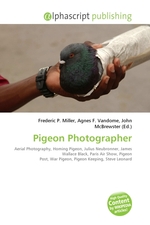Pigeon Photographer
Frederic P. Miller, Agnes F. Vandome, John McBrewster
бумажная книга
High Quality Content by WIKIPEDIA articles! The pigeon photographer was a technique for aerial photography, invented in the year 1907 by the German apothecary Julius Neubronner. A homing pigeon was fitted with an aluminum breast harness to which could be attached a lightweight time-delayed miniature camera. The German experiments stopped after World War I because of lack of military or commercial interest in the technology, but were briefly taken up by a Swiss clockmaker and reportedly also by the German and French militaries and the CIA. The first aerial photographs were taken in 1858 by the balloonist Nadar; in 1860 James Wallace Black took the oldest surviving aerial photographs, also from a balloon. Advances in photographic techniques made their use in unmanned aircraft feasible at the end of the 19th century. In the 1880s, Arthur Batut experimented with kite aerial photography. Many others followed him, and high-quality photographs of Boston taken with this method by William Abner Eddy in 1896 became famous. Amedee Denisse equipped a rocket with a camera and a parachute in 1888, and Alfred Nobel also used rocket photography in 1897.
Данное издание не является оригинальным. Книга печатается по технологии принт-он-деманд после получения заказа.


